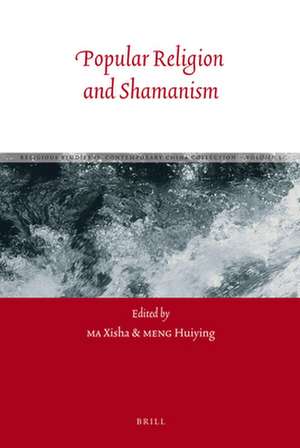Popular Religion and Shamanism: Religious Studies in Contemporary China Collection, cartea 1
Editat de Xisha MA, Huiying MENG Traducere de Zhen Chi, Thomas DuBoisen Limba Engleză Hardback – 13 feb 2011
Preț: 1082.75 lei
Preț vechi: 1320.43 lei
-18% Nou
Puncte Express: 1624
Preț estimativ în valută:
207.19€ • 217.31$ • 172.48£
207.19€ • 217.31$ • 172.48£
Carte indisponibilă temporar
Doresc să fiu notificat când acest titlu va fi disponibil:
Se trimite...
Preluare comenzi: 021 569.72.76
Specificații
ISBN-13: 9789004174559
ISBN-10: 9004174559
Pagini: 499
Dimensiuni: 155 x 235 x 33 mm
Greutate: 0.91 kg
Editura: Brill
Colecția Brill
Seria Religious Studies in Contemporary China Collection
ISBN-10: 9004174559
Pagini: 499
Dimensiuni: 155 x 235 x 33 mm
Greutate: 0.91 kg
Editura: Brill
Colecția Brill
Seria Religious Studies in Contemporary China Collection
Cuprins
Part I: Popular Religion Translated by Chi Zhen
Introduction
Thomas David DuBois
Chapter 1: The Syncretism of Maitreyan Belief and Manichaeism in Chinese History
Ma Xisha
Chapter 2: A Study on Equivalent Names of Manichaeism in Chinese
Lin Wushu
Chapter 3: On the Rise, Decline and Evolution of the Three-in-One Teaching
Lin Guoping
Chapter 4: The Evolution of the Luo Teaching and the Formation of Green Gang
Ma Xisha
Chapter 5: The Taigu School and the Yellow Cliff Teaching: Another Case of Transformation from Confucian Academic Group to Religious Sect
Han Bingfang
Chapter 6: Exploring the History of the Yihetuan
Lu Yao
Chapter 7: A Preliminary Investigation on the Early History of the Way of Penetrating Unity and its Relationship with the Yihetuan
Zhou Yumin
Chapter 8: Women in the Secret Popular Religions of the Ming and Qing Dynasties
Yu Songqing
Bibliography
Part II: Shamanism Translated by Anne Henochowicz, Yun C. Lee, Li Hui, Cheryl Cornwell, Timothy Thurston, Yang Qiong, Zhou Hao, Levi Gibbs, Hao-hsiang Liao, and Rongbin Zheng
Introduction
Mark Bender and Kun Shi
Chapter 9: Mongol Shaman Initiation Rites: Case Studies in Eastern Inner Mongolia
Guo Shuyun
Chapter 10: Characteristics of Shamanism of the Tungusic Speaking People
Meng Huiying
Chapter 11: Daba Beliefs and Written Script
Song Zhaolin
Bibliography
Introduction
Thomas David DuBois
Chapter 1: The Syncretism of Maitreyan Belief and Manichaeism in Chinese History
Ma Xisha
Chapter 2: A Study on Equivalent Names of Manichaeism in Chinese
Lin Wushu
Chapter 3: On the Rise, Decline and Evolution of the Three-in-One Teaching
Lin Guoping
Chapter 4: The Evolution of the Luo Teaching and the Formation of Green Gang
Ma Xisha
Chapter 5: The Taigu School and the Yellow Cliff Teaching: Another Case of Transformation from Confucian Academic Group to Religious Sect
Han Bingfang
Chapter 6: Exploring the History of the Yihetuan
Lu Yao
Chapter 7: A Preliminary Investigation on the Early History of the Way of Penetrating Unity and its Relationship with the Yihetuan
Zhou Yumin
Chapter 8: Women in the Secret Popular Religions of the Ming and Qing Dynasties
Yu Songqing
Bibliography
Part II: Shamanism Translated by Anne Henochowicz, Yun C. Lee, Li Hui, Cheryl Cornwell, Timothy Thurston, Yang Qiong, Zhou Hao, Levi Gibbs, Hao-hsiang Liao, and Rongbin Zheng
Introduction
Mark Bender and Kun Shi
Chapter 9: Mongol Shaman Initiation Rites: Case Studies in Eastern Inner Mongolia
Guo Shuyun
Chapter 10: Characteristics of Shamanism of the Tungusic Speaking People
Meng Huiying
Chapter 11: Daba Beliefs and Written Script
Song Zhaolin
Bibliography
Recenzii
"...this monograph provides solid information on Chinese popular religion and shamanism in a single convenient volume, with contributions from the leading Chinese experts in the field."
Richard Shek, California State University, Sacramento, Journal of Chinese Religions No. 40 (2012)
Richard Shek, California State University, Sacramento, Journal of Chinese Religions No. 40 (2012)
Descriere
Popular Religion and Shamanism addresses two areas of religion within Chinese society; the lay teachings that Chinese scholars term folk or “popular” religion, and shamanism. Each area represents a distinct tradition of scholarship, and the book is therefore split into two parts. Part I: Popular Religion discusses the evolution of organized lay movements over an arc of ten centuries. Its eight chapters focus on three key points: the arrival and integration of new ideas before the Song dynasty, the coalescence of an intellectual and scriptural tradition during the Ming, and the efflorescence of new organizations during the late Qing.
Part II: Shamanism reflects the revived interest of scholars in traditional beliefs and culture that reemerged with the “open” policy in China that occurred in the 1970s. Two of the essays included in this section address shamanism in northeast China where the traditions played an important role in the cultures of the Manchu, Mongol, Sibe, Daur, Oroqen, Evenki, and Hezhen. The other essay discusses divination rites in a local culture of southwest China. Both sections of Popular Religion and Shamanism will introduce Western readers to the ideas of Chinese scholars, not just their data.
Part II: Shamanism reflects the revived interest of scholars in traditional beliefs and culture that reemerged with the “open” policy in China that occurred in the 1970s. Two of the essays included in this section address shamanism in northeast China where the traditions played an important role in the cultures of the Manchu, Mongol, Sibe, Daur, Oroqen, Evenki, and Hezhen. The other essay discusses divination rites in a local culture of southwest China. Both sections of Popular Religion and Shamanism will introduce Western readers to the ideas of Chinese scholars, not just their data.



